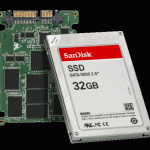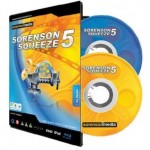Category: General
Solid State, the Future of Storage
 REVISION* Since the VHS ( and Beta for you Sony lovers ) back in the early eighties, recording formats have been one of the slowest forms of a growing technology in the A/V industry. Digi-Beta and BetaCam have long been the standard for the industry but as the song goes, “the time’s, they are a changing” .From DVD’s and mini-discs all the way to hard drives, the techies have been plotting to remove tape and install a new standard, and slowly but surely over the past few years production studios have started to come on board. Broadcast stations have been and are continuing to make the switch to tapless media both in storage and recording formats, and industry enthusiasts seems ready to make tape a thing of the past.
REVISION* Since the VHS ( and Beta for you Sony lovers ) back in the early eighties, recording formats have been one of the slowest forms of a growing technology in the A/V industry. Digi-Beta and BetaCam have long been the standard for the industry but as the song goes, “the time’s, they are a changing” .From DVD’s and mini-discs all the way to hard drives, the techies have been plotting to remove tape and install a new standard, and slowly but surely over the past few years production studios have started to come on board. Broadcast stations have been and are continuing to make the switch to tapless media both in storage and recording formats, and industry enthusiasts seems ready to make tape a thing of the past.
Read More
Compositing…NLE or Third Party?
 Compositing can be a very deep and complex subject, especially when dealing with animation, but here we’ll try and keep it fairly simple and straightforward. There is always talk amongst those in the industry when it comes to blue/green screen and working on an edit as to whether or not one should do their composite in whatever NLE software their working with or export to a third party software to handle the task. Unless your working with animation, the answer, like so many in post production questions is a not a simple one. Take for instance Avid, who has excellent composite tools available in their 3.0 versions ( and up ) that can do the job relatively pain free providing the ‘screen’ is a talking head or has minimal movement. Final Cut does a decent job too, providing your using the newly acquired Ultimatte software that was made available earlier this year. Both are good and most editor’s may prefer to use their NLE system to avoid the hassle of exporting and re-importing footage for what may be no difference other than minor ones no one notices.
Compositing can be a very deep and complex subject, especially when dealing with animation, but here we’ll try and keep it fairly simple and straightforward. There is always talk amongst those in the industry when it comes to blue/green screen and working on an edit as to whether or not one should do their composite in whatever NLE software their working with or export to a third party software to handle the task. Unless your working with animation, the answer, like so many in post production questions is a not a simple one. Take for instance Avid, who has excellent composite tools available in their 3.0 versions ( and up ) that can do the job relatively pain free providing the ‘screen’ is a talking head or has minimal movement. Final Cut does a decent job too, providing your using the newly acquired Ultimatte software that was made available earlier this year. Both are good and most editor’s may prefer to use their NLE system to avoid the hassle of exporting and re-importing footage for what may be no difference other than minor ones no one notices.
Read More
Using Sorenson Squeeze for Flash
 Having worked as an editor for over seven years now, I think it’s safe to say that I’ve had the opportunity to export to the majority of different formats one can. But now days I find more and more that both clients and studios alike are asking for streaming video for the web. It may seem simple for some, especially considering all the YouTube videos that are uploaded these days, however, uploading to YouTube and properly putting video on a company website is completely different. Usually I find out about how improperly it was done after the fact, and usually the people involved don’t understand what they did wrong. So here we go.
Having worked as an editor for over seven years now, I think it’s safe to say that I’ve had the opportunity to export to the majority of different formats one can. But now days I find more and more that both clients and studios alike are asking for streaming video for the web. It may seem simple for some, especially considering all the YouTube videos that are uploaded these days, however, uploading to YouTube and properly putting video on a company website is completely different. Usually I find out about how improperly it was done after the fact, and usually the people involved don’t understand what they did wrong. So here we go.
There are alot of great programs out there but I prefer using Sorenson Squeeze. It’s an excellent program which gives the user full control over all aspects of the encoding process, which is one of the main reasons why most people who are not industry savvy find it overwhelming. Another very notable mention regarding Sorenson Squeeze, is that it carries one of the most important plug-in’s, On2Vp6, which is specifically for the purpose of exporting Flash. On2Vp6 is a codec that gives you incredibly good video quality at a very small file size, but it’s also important to understand all the other options in Sorenson Squeeze as well to see what exactly to set your settings too. I’ll give you the most important three.
1. First off, like I mentioned set your codec to On2VP6, which you may have to pay for given the fact that it is a licened plug-in.
2. Next your bitrate. Now although you can go as high as you like you have to consider the fact that this is not just your video to watch. People have to actually stream this, so going to high may limit some’s ability to watch the video without major delays. In order to balance quality with a reasonable load time I would say to put your video ( should it be within reasonable size, ie 360 x 240 or 480 x 360) to around 500 kbs. This should give you great video quality without too much lag.
3. An overlooked aspect is the buffer. I can’t tell you how many times I get people complaining that they did everything right yet there still getting their video pausing in the middle since the it hasn’t finished buffering ( or in other words fully loading). Sorenson gives you full control over all the buffer options so you can experiment to see what you prefer. If your a real stickler about your video and you want no chance of a lag since it can ruin the “flow”, you need to set you starting buffer to around the 20 second mark and adjust your other buffer sizes according ( there are two others – optimal and maximum, just look at the difference between starting and the others and adjust them up).
So that’s it. Now you can enjoy uploading great quality video in a small size to the web that people of all web server speeds will be able to appreciate. Since this can be a source of frustration for new users, feel free to email me if you get stuck or have any questions.
Apple’s ProRes Captures Nascar
 It seems like Apple is weaving it’s way into the fast these days. As announced last year, NASCAR Media Group is preparing for a transition to HD, which will include a move into a new 40,000-square-foot facility in Charlotte North Carolina. The transition will also mark NASCAR Media Group’s move to an all Apple ProRes workflow. NMG is the primary television production company for the sport of NASCAR, is using Macs and 16 AJA Kona 3 cards for ingesting the 150 hours of multi-camera footage shot at each race. An additional 18 Kona 3 cards are used for editing playback in NMG’s 10 edit bays, as well as to handle duplication and new media, and to support field operations for the NASCAR Sprint Cup Series and NASCAR Nationwide Series. This polishes their existing DIVArchive System by adding this new Apple Interface.
It seems like Apple is weaving it’s way into the fast these days. As announced last year, NASCAR Media Group is preparing for a transition to HD, which will include a move into a new 40,000-square-foot facility in Charlotte North Carolina. The transition will also mark NASCAR Media Group’s move to an all Apple ProRes workflow. NMG is the primary television production company for the sport of NASCAR, is using Macs and 16 AJA Kona 3 cards for ingesting the 150 hours of multi-camera footage shot at each race. An additional 18 Kona 3 cards are used for editing playback in NMG’s 10 edit bays, as well as to handle duplication and new media, and to support field operations for the NASCAR Sprint Cup Series and NASCAR Nationwide Series. This polishes their existing DIVArchive System by adding this new Apple Interface.
“Bringing DIVArchive and Apple together in a unified environment will make it easy for producers and editors working in Final Cut Pro to restore content from anywhere within the system including the datatape library,” said Jeff Lowe, managing director for media and broadcast technology at NASCAR Media Group. “The flexibility of DIVArchive and our close partnership with Front Porch Digital are key to simplifying our production process and helping to secure our valuable media assets while at the same time supporting higher quality new programming by giving our staff even easier access to thousands of hours of historic clips in our archive.”
